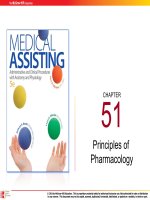Lecture Medical assisting: Administrative and clinical competencies (2/e) - Chapter 19
Bạn đang xem bản rút gọn của tài liệu. Xem và tải ngay bản đầy đủ của tài liệu tại đây (779.61 KB, 48 trang )
PowerPoint® to accompany
Medical Assisting
Chapter 19
Second Edition
Ramutkowski Booth Pugh Thompson Whicker
Copyright © The McGraw-Hill Companies, Inc. Permission required for reproduction or display.
1
Principles of Asepsis
Objectives
191 Explain the historical background of infectious
disease prevention.
192 Identify the types of microorganisms that cause
disease.
193 Explain the disease process.
194 Explain how the body’s defenses protect against
infection.
195 Describe the cycle of infection.
2
Principles of Asepsis
Objectives (cont.)
196 Identify and describe the various methods of
disease transmission.
197 Explain how you can break the cycle of infection.
198 Compare and contrast medical and surgical
asepsis.
199 Describe how to perform aseptic hand washing.
3
Principles of Asepsis
Objectives (cont.)
1910 Define Bloodborne Pathogens Standards and
Universal Precautions as described by the rules
and regulations of the Occupational Safety and
Health Administration (OSHA)
1911 Explain the role of Universal Precautions in the
duties of the medical assistant.
4
Principles of Asepsis
Objectives (cont.)
1912 List the procedures and legal requirements for
disposing of hazardous waste.
1913 Explain how to educate patients in preventing
disease transmission.
5
Introduction
Our bodies are
amazing structures
that defend us
against infections
under normal
circumstances.
You will learn:
About disease causing
microorganisms.
How the body fights
against disease.
Ways infections occur
You can be instrumental in helping to break the cycle of
infection by practicing asepsis in the office and educating
patients in the prevention of disease transmission.
6
History of Infectious Disease
Prevention
Hippocrates – first attempt to
prevent infection. He believed:
Environment and natural
forces play an important part
in role of disease and health
Simple treatments, using
strong drugs and surgery
only as a last resort.
7
Joseph Lister
Discovered how to use
chemical antiseptics
to control surgery
related infections
Used antiseptics to
disinfect surgical
equipment and
supplies
Microorganisms are simple forms of life commonly made
up of a single cell only seen with a microscope.
8
Holmes and Semmelweis
Holmes
Demonstrated that
puerperal fever was
carried from
patient to patient
by doctors.
Semmelweis
Also concluded
puerperal fever
was a
communicable
disease.
9
Microorganisms
Microorganisms live all around us.
Viruses – smallest infectious agent
Viruses
Bacteria – single celled reproduced quickly
Bacteria
Protozoans – single celled found in soil
Protozoans
(most do not cause disease)
Fungi – complex cell structure (most do not
Fungi
cause disease)
Parasites – cause disease
Parasites
10
Disease Process
Begins with
Damage is caused
microorganisms
by:
Depleting nutrients
finding host
Reproducing
Grows with specific
themselves
requirements
Making body cells
Proper temperature,
the target of body’s
pH, and moisture level
own defenses
Produce toxins
11
Body’s Defenses
Immunity – resistant to pathogens and the
disease they cause
If defenses are not functioning properly,
person will become susceptible to invasion and
infection.
Lines of Defense
Skin
Normal flora
Staying healthy
12
Defenses Against Disease
Nonspecific Defenses
Infection is the
presence of a
Species resistance
pathogen in or on the
Mechanical
body
barriers
Nonspecific defenses
Chemical barriers
mechanisms to
Fever
protect us against
Inflammation
pathogens in general
Phagocytosis
13
Specific Defenses Against
Disease
Lymphocytes and
macrophages are
Protects the body
the major cells
against very specific
pathogens
Antibodies and
complement are
the major
proteins involved
in specific
defenses
Immunity
14
Apply Your Knowledge
What are three lines of defense against
microorganisms?
15
Apply Your Knowledge Answer
What are three lines of defense against
microorganisms?
Lines of Defense
Skin
Normal flora
Staying healthy
16
Types of Immunity
Naturally acquired active – naturally
exposed to an antigen (usually long
lasting)
Artificially acquired – being injected
with a pathogen (immunizations or
vaccines)
Naturally acquired passive – immunity
through his mother (shortlived)
Artificially acquired passive –
immunity when person is injected with
antibodies (shortlived)
17
T Cells
Helper T cells
increase antibody formation, memory cell
formation, B cell formation, and phagocytosis
Memory T cells
memory cells “remember” the pathogen that
activated the original T cell
person is later exposed to the same pathogen,
memory cells trigger an immune response that
is more effective than the first immune response
18
CellMediated Immunity
Two major types of lymphocytes
B Cells and T Cells
Recognize antigens in the body
B cells:
Respond to antigens by
becoming plasma cell
-make antibodies
against the specific
antigen
T Cells:
Cell-mediated
bind to antigens
on cells and attack
them directly
19
Cycle of Infection
A reservoir host –animal, insect or human body
where pathogen is growing (carrier, unaware of
presence of pathogen)
Means of exit – pathogen must exit the host
Means of exit
Nose, mouth, eyes or ears
Feces or urine
Semen, vaginal fluid or other reproductive
discharge
Blood or blood products
Click for Cycle of Infection
20
Cycle of Infection (cont.)
Means of transportation – must spread to another host
Means of transportation
by some means of transmission
Vectors – living organisms, insects or person
Vectors
Fomites – inanimate objects such as clothing, water,
Fomites
food
Airborne transmission
Bloodborne transmission
Ingested transmission
Touching
During pregnancy or birth
Click for Cycle of Infection
21
Cycle of Infection (cont.)
Means of Entrance
Enter through any cavity lined with
mucous membrane
Mouth, nose, vagina, rectum
Through ears, eyes, intestinal tract, urinary
tract, reproductive tract, breaks in the skin
Click for Cycle of Infection
22
Cycle of Infection (cont.)
Susceptible Host determined by:
Age
Genetic predisposition
Nutritional status
Disease process
Stress levels
Hygiene habits
Click for Cycle of Infection
23
Cycle of Infection (cont.)
Back
24
Apply Your Knowledge
What are fomites?
25









